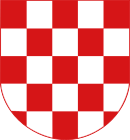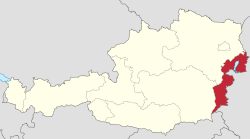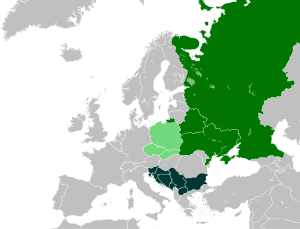Burgenland Croats
| Part of a series on |
| Croats |
|---|
 |
|
Subgroups |

Burgenland Croats (Croatian: Gradišćanski Hrvati, German: Burgenlandkroaten, Hungarian: Burgenlandi horvátok, Slovak: Gradiščanskí Chorváti) is the name for ethnic Croats in the Austrian state of Burgenland and neighboring regions of Hungary and Slovakia.[1]
There are around 120,000 Croats that live in Austria. 27,000[2] to 30,000[1] of them are Burgenland Croats. Another 56,785 out of them had Croatian citizenship.[2]
Since 1993 Croatian organizations are appointing their representatives to the Council for National Minorities of the Austrian government.
History
Burgenland Croats began to emigrate from Lika, Krbava, Kordun, Banovina, Moslavina, Western Bosnia and Gorski Kotar, areas that were occupied by the Turks, in the 16th century during the Turkish wars (1533-1584). Refugee Croats were given land and independent ecclesiastic rights by the Austrian King Ferdinand I because many of their villages had been pillaged by the Turks. This gave the Croats a safe place to live while providing Austria with a buffer zone between Vienna and the Ottoman Empire to the south and east.

The first wave of emigration came in the 1530s after the Turks destroyed almost all the settlements between the river Una and the mountain Velebit, and the river Kupa and the mountain range Kapela. In the second wave of emigration in the 1540s many Croats left Slavonia. The third and last wave of emigration, came in the 1750s and 1760s.
Burgenland Croats emigrated not only because of the fear of Turkish attacks but also because they were searching for jobs and better life opportunities.
The emigration went mainly to the north, but also across the Adriatic Sea to Italy, where Molise Croats can be found today.
The Burgenland Croats developed their own orthography during the counter-reformation, however, assimilation soon followed with the language being banned from use in churches and schools.
After falling under Hungarian rule in the Dual Monarchy, liberal laws regarding ethnicity enabled them to rekindle their language and heritage. However, when a 1900 census revealed that only 18.8% of the population of Burgenland spoke Hungarian, drastic measures of Magyarization were taken, thus revoking many individual and community rights. The Burgenland Croats were also persecuted by Austro-German nationalists after World War I and by the Nazis during World War II and were exposed to attempts of assimilation.
The Croats gained minority status in the Austrian Treaty of Independence of 1955. Since then, they and their culture have undergone something of a renaissance with the language being taught at schools and spoken in Church wherever there is a large enough minority.
Language

Despite many languages that surround them Burgenland Croats preserved their Croatian language and its dialects from all Croatian regions from which they originated. Burgenland Croatian language as well as the general Croatian standard language combines Chakavian, Shtokavian and Kajkavian dialect. But unlike Croatian standard language which is mostly based on the most widespread Shtokavian dialect, Burgenland variant of the Croatian language is based on Chakavian dialect. Burgenland Croatian includes phrases no longer used in standard Croatian as well as certain phrases and words taken from German and Hungarian. Names are often written according to Hungarian orthography due to Magyarisation during the late 19th and early 20th centuries. Nearly all Burgenland Croats are fluent in German.
After the dissolution of the Austro-Hungarian monarchy in 1918 area in which Burgenland Croats lived were divided between Austria, Czechoslovakia and Hungary. After 1921 most of these areas became part of Austria, which established a new province of Burgenland, after which the Croatian minority was named. In 1922 Austria founded the Apostolic administration of Burgenland and began to abolish bilingual schools thru the introduction of the teaching of German language in all primary schools. This process was temporarily stopped after The National Education Act, that allowed the work of the Croatian elementary schools, was adopted. After Hitler annexed Austria in 1938 this law was abolished. In 1955 the Austrian State Treaty was signed. It gave permission to the Burgenland Croats to use Croatian language in education, judiciary and public administration. With the adoption of the Law on National Minorities in 1976 use of the Croatian language in public life become limited. After constitutional complaint was accepted in 1987 parts of the law were changed and the Croatian language was introduced as an official in 6 out of 7 districts of Burgenland.[1]
Newspapers of the Burgenland Croats are: Crikveni glasnik (Church Gazett), 1946; Naše selo (Our village), 1947; Naš tjednik (Our weekly), 1947; Naša domovina (Our homeland), 1952; Glas (Voice), 1957; Novi glas (New Voice), 1969; Put (Way), 1981).
The beginnings of literacy are linked to: Klimpuški misal (Klimpuški Missal) (1501), S. Consul Histrianus and Anton Dalmatin's Postila (Fasting) (1568), Duševne pesne (Spiritual songs) (1609) and Grgur Mekinić Pythiraeus's Druge knjige duševnih pesan (Other books of the Spiritual songs) (1611). By the mid-19th literature had religious character and was intended mostly for peasants. Main writers were priests and nuns. In the second half of the 19th century teachers begin to write. Thanks to that many school textbooks and calendars were written.
Most popular Burgeland Croat writer are: J. Mulih (1694–1754), Godefrid Palković (1714–78), L. Bogović (1719–89), E. M. Kragel (1725–88), M. Laáb (cca. 1746–1823), J. Ficko (1772–1843), M. Drobilić (1808–91), T. Jordan (1815–93), G. Glavanić (1833–72), M. Naković (1840–1900), I. Mušković (1848–1930), M. Borenić (1850–1939), Ivan Čuković (1865–1944), P. Jandrišević (1879–1938), I. Blažević (1888–1946), Mate Meršić Miloradić (1850–1928), Ignac Horvat (1895–1973), Martin Meršić, A. Blazović (1921–2004), Franz Probst (1919–93), N. Benčić (b. 1938), Ivan (Lav) Sučić (b. 1938), Mathilda Bölcs (b. 1949), J. Čenar (b. 1956), P. Tyran (b. 1955) and H. Gassner (b. 1955).[1]
The first book about history of Burgenland literature, Naši pisci i književnost (Our writers and literature), was written by F. Sedenik in 1912.
Organisations of the Burgenland Croats
- Hrvatsko gradišćansko kulturno društvo u Beču (Burgenland Croatian Culture Association in Vienna), 1934
- Hrvatsko nakladno društvo (Croatian Publishers Association), 1947-since 1960 Hrvatsko štamparsko društvo (Croatian Press Association)
- Hrvatski akademski klub u Beču (Croatian Academic Club in Vienna), 1948
- Komitet za prava gradišćanskih Hrvata (Committee on the Rights of the Burgenland Croats), 1972
In 1960 Diocese Eisenstadt was founded.
Groups and villages in which they live
By the name and dialect there are these different groups of Burgeland Croats:
.jpg)
- Štoji- settled in the far south of Burgenland in villages: Pinkovac (Güttenbach), Nova Gora (Neuberg) and Stinjaki (Stinatz), is a Shtokavian–(south)Chakavian mixed dialect
- Vlahi- settled north of Štoj's in the Croatian villages: Cikljin (Spitzzicken; they speak Štokavian), Bandol (Weiden bei Rechnitz), Podgorje (Podgoria; they speak Štokavian), Stari Hodaš (Althodis), Sabara (Zuberbach), Čemba (Schandorf), Vincjet (Dürnbach), Ključarevac (Allersdorf), Čajta (Schachendorf), Rorigljin-Širokani (Rauhriegel-Allersgraben), is Shtokavian (schacavian) ikavian dialect similar to Slavonian
- Dolinci- settled north of Vlah's and south of Poljanci. Their villages are: Bajngrob (Weingraben), Kalištrof (Kaisersdorf), Dolnja Pula (Unterpullendorf), Frakanava (Frankenau), Šuševo (Nebersdorf), Filež (Nikitsch), Gerištof (Kroatisch Geresdorf), Mučindrof (Großmutschen), Pervane (Kleinmutschen), Veliki Borištof (Großwarasdorf), Mali Borištof (Kleinwarasdorf), Longitolj (Langenthal) and Mjenovo (Kroatisch Minihof), is a (middle)Chakavian dialect
- Poljanci, settled east of the city of Mattersburg and west of Lake Neusiedl. Their villages are: Pajngrt (Baumgarten), Rasporak (Draßburg), Otava (Antau), Cogrštof (Zagersdorf), Klimpuh (Klingenbach), Cindrof (Siegendorf), Prodrštof (Wulkaprodersdorf), Trausdorf (Trausdorf), Uzlop (Oslip), Vorištan (Hornstein), Štikapron (Steinbrunn) and Celindof (Zillingtal), is a (middle)Chakavian dialect
- Haci- settled northeast of Lake Neusiedl. Their villages are: Pandrof (Parndorf), Novo Selo (Neudorf bei Parndorf) and Bijelo Selo (Pama), is a (middle)Chakavian dialect
- some Croats speak a Kajkavian dialect near Neusiedl
- Grob dialect: a Kajkavian dialect, spoken in Chorvátsky Grob in Slovakia
Burgenland Croats in Hungary and Slovakia
Some Burgenland Croats live in Slovakia (Hrvatski Grob (Chorvátsky Grob), Hrvatski Jandrof (Jarovce), Devinsko Novo Selo (Devinska Nova Ves) and Čunovo, as well as in Hungary: Hrvatska Kemlja (Horvátkimle), Bizonja (Bezenye), Koljnof (Kópháza), Vedešin (Hidegség), Temerje (Tömörd), Plajgor (Ólmod), Petrovo Selo (Szentpéterfa), Hrvatske Šice (Horvátlövő), Gornji Čatar (Felsőcsatár), Umok (Fertőhomok), Narda, Hrvatski Židan (Horvátzsidány) Prisika (Peresznye) and Unda (Und).
